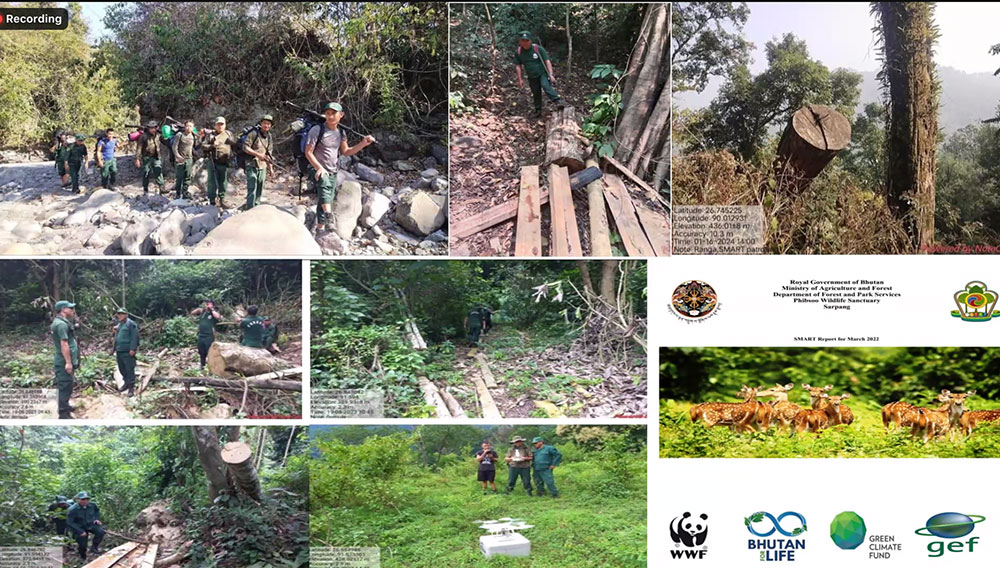YK Poudel
In the battle against poaching, ‘technology’ stands as a crucial ally. Rangers on the frontline confront a myriad of challenges, from tackling illegal activities spanning local and transboundary territories to grappling with limited technical know-how, poor accessibility, and inadequate patrol gears.
Khandu Tshomo works as a forestry official at Phibsoo Wildlife Sanctuary. She is one of the few women who specialise in using a tool called Spatial, Monitoring, Analysis, Reporting, Tool (SMART).
Speaking on March 18 about “Using SMART to Stop Wildlife and Forest Crimes in Phibsoo Wildlife Sanctuary,” Khandu Tshomo shared how forest officials nationwide are using the SMART tool. She mentioned ongoing challenges like coordination between different agencies, the training level of officials, and illegal activities crossing borders.
“It’s crucial to have timely actions, like using standardized data protocols, to shape policies and advocate for change,” Tshomo said. “By enhancing interventions through initiatives from the Department of Forests and Park Services (DoFPS), strategies like training and using technology together for a united approach are proving to be effective.”
Tshomo said that Bhutan began testing SMART at Royal Manas National Park in 2013. Then, in 2014, they conducted a ‘training of trainers’ programme. The government officially adopted the program nationwide in 2015. In 2018, a core group was formed to oversee the implementation. In 2020, the government endorsed the SMART implementation protocol. This led to expanding SMART to 10 national parks and 14 forest divisions.
Thanks to these efforts, by last year, SMART was successfully implemented across the entire country.
Khandu Tshomo noted that both government and non-government organisations have supported the project’s implementation nationwide. She mentioned that the data gathered through the SMART tool is accessible to relevant officials. This data is then analyzed to inform policy interventions at the national level.
Since 2015, DoFPS along with the World Wildlife Fund (WWF) Bhutan launched the SMART patrolling system. This system serves as a crucial tool in the fight against poaching.
The SMART tool is capable of tracking various issues such as human-wildlife conflicts, illegal wildlife trade, and the impacts of pests and diseases. It helps rangers gather field information using handheld devices, which can then be shared, analysed, and used to take action.
Sethu Gopinathan, Assistant Manager at the Wildlife Crime Control Division of the Wildlife Trust of India, discussed the use of ‘Hostile Activity Watch Kernel’ (HAWK) technology in combating wildlife crimes in India.
He said that the HAWK tool operates through four modules: forest and wildlife crime documentation, wildlife death monitoring, forest and wildlife crime monitoring, and check-post management.
Sethu Gopinathan mentioned that the HAWK tool has been in use since 2017, with Kerala and Karnataka already implementing it. Additionally, the states of Uttar Pradesh, Tamil Nadu, and Uttarakhand are planning to implement it soon. He emphasized the goal of expanding the implementation of the tool across India.
“The advantage of HAWK lies in its ability to record real-time data in the system and map conflict hotspots, which aids in formulating national and regional policies,” he said.
Pradeep Bhattarai presented a case from Nepal, stating that the country has 20 protected areas, which make up 23 percent of its total land area.
“SMART patrol, an innovative tool launched in 2014, is designed to help rangers track and prevent illegal wildlife trade and poaching,” he said.
According to him, Nepal is the first country to deploy a fully automated real-time patrol monitoring system in the field of conservation.
Wildlife crime and interventions
Globally, illegal wildlife trade has become the fifth most profitable illicit trade, generating over USD 10 billion annually.
DoFPS, as the central agency in Bhutan, focuses on raising awareness and advocating for wildlife conservation and legislation. The division has improved its analysis of hotspots and strategically deployed staff for anti-poaching patrols and surveillance. Additionally, the police, army, judicial system, and civil society organisations (CSOs) in the country are collaborating to minimize the impact of conflicts.
According to records from DoFPS, the most commonly poached animals for illegal trade include musk deer, serow, tiger, Asiatic elephant, pygmy hog, sambhar, Asiatic black bear, common leopard, and pangolin.
In 2023, the Department recorded 1,249 forest and wildlife offences nationwide. This number showed a slight decrease compared to 2022. Among these offences, 31 cases were related to wildlife poaching, involving 11 different species.
Bhutan has 1,233 active rangers working across the four Functional Divisions, 14 Divisional Forest Offices (DFO), and 10 Park Offices throughout the country.
Looking ahead
To combat wildlife crime, poaching, and retaliatory killings, the Conservation Law Enforcement Curriculum Framework (CLECF) was launched last year. This initiative ensures that those responsible for safeguarding wildlife receive updated skills and knowledge.
In 2021, Bhutan established a regional hub to address the issues of illegal poaching and trade, supported by vital data and information essential for policy-making. Additionally, Bhutan joined 12 other Tiger Range Countries in efforts to eradicate poaching in critical sites for tigers, elephants, and rhinos.
This strategy aims to foster better and more organised partnerships between different agencies.
At the community level, the focus is on engaging, involving, and empowering communities to reduce human-wildlife conflicts.
Various initiatives such as electric fences, insurance schemes, and community-based response groups have been initiated, although their success has been somewhat limited up to now.


